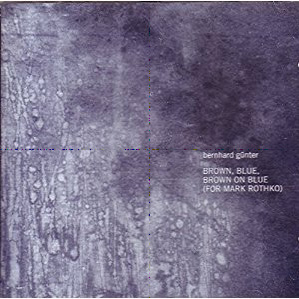Mark Rothko (1903-1970)
Bernhard Günter (*1957)
"I am not an abstract painter. I am not interested in the relationship between form and color. The only thing I care about is the expression of man’s basic emotions: tragedy, ecstasy, destiny."
Mark Rothko
Rothko Foundation:
Photo and cover: Bernhard Günter, 2008

CD erhältlich als mp3-Download bei: www.klangstaub.com
"This web release replaces trente oiseaux CD TOC001 "
Bernhard Günter: Brown, Blue, Brown on Blue (for Mark Rothko)
composed 1999
trente oiseaux CD TOC001, Germany 1999
Cover image: courtesy Bernhard GŁnter
Liner notes: Bernhard Günter, October 1999
No. 61 (Rust and Blue) Brown Blue, Brown on Blue (1953)
Ausstellung:
2006 MOCA Showcases Its Mark Rothko Collection, Chief Curator Paul Schimmel;
The Museum of Contemporary Art, Los Angeles (MOCA)
www.moca.org
"This exhibition includes 8 of Rothko's major paintings spanning the period from 1947 to 1960."
"It is dedicated to my favorite painter, Mark Rothko, and the title is taken from one of his paintings that has accompanied me for a long time as print hanging beside my bed. I finally got a chance to see this painting in an exhibition of Rothko's works at the Musée de l'Art Moderne de la Ville de Paris in 1999 and was more deeply touched by it than i can express in words."
Bernhard Günter
"I finished "Brown, Blue, Brown on Blue (for Mark Rothko)" in mid-july 1999, and it picks up where "Slow Gestures / Cérémonie Désir (for Heike)" left off (actually, the two pieces can be listened to as one large work in two parts...)".
"These strong feelings have found their way into the composition i began working on immediately after my visit at the museum - it is not intended to describe the painting itself, but rather the emotions it inspired. The itinerary the work takes is, in some respect, a reversed mirror image of the development of Rothko's painting during his life: where Rothko began his characteristic style with bright colors and ended in dark grays and blacks, i am starting with dark colors implying his tragic death to end in a kind of celebration of his greatness being recognized by so many people now, and the heritage of wonderful works he has left us."
Bernhard Günter
Morton Feldman: Rothko Chapel, 1991